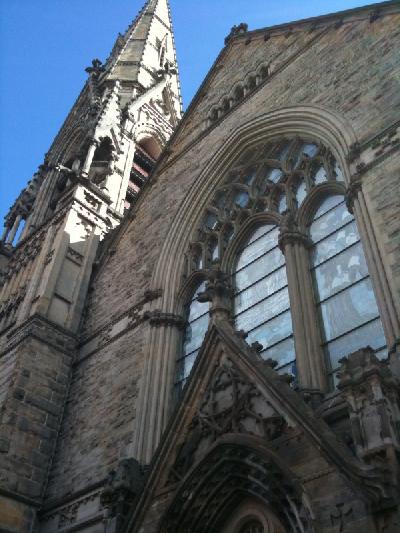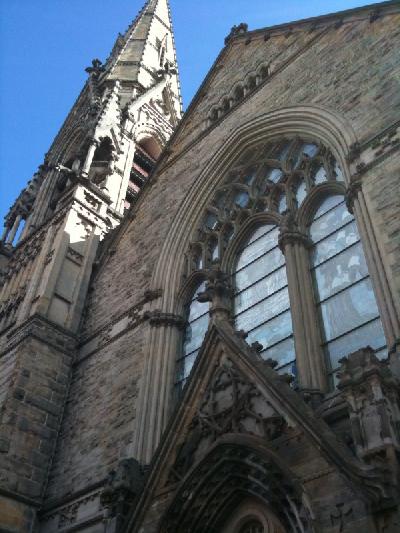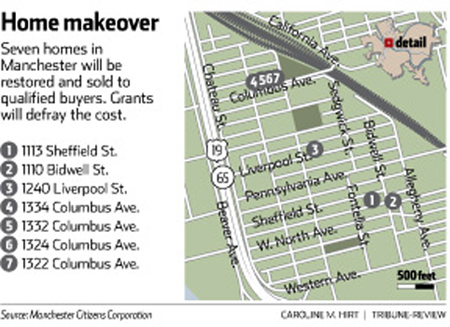
Category Archive: National Historic Landmarks
-
Carnegie’s Library Legacy
The Carnegie struggles with honoring the past while serving the present and future
Sunday, March 02, 2003
By Patricia Lowry, Post-Gazette Architecture Critic
From Fiji to Florida to Fresno, Calif., Andrew Carnegie built 2,509 libraries between 1881 and 1917, mostly in America, the British Isles and Canada. To this day, Carnegie’s free-to-the-people libraries remain Pittsburgh’s most significant cultural export, a gift that has shaped the minds and lives of millions.
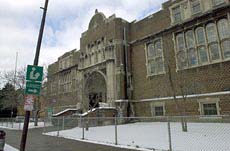
The Homewood library opened at the corner of Hamilton Avenue and Lang Street in 1910. Today the branch becomes the first to be rehabilitated in Carnegie Library of Pittsburgh's $40 million systemwide renovation, libraries also must accommodate information available through electronic media. New computer stations are among the updates in the Homewood makeover, which restores major architectural elements while sacrificing others considered less significant. (Joyce Mendelsohn, Post-Gazette)
From the monumental libraries of the Monongahela Valley steel towns to the smaller branch libraries in Pittsburgh neighborhoods, the Carnegie library buildings of Western Pennsylvania also have a national significance — and for some, an uncertain future.
In Pittsburgh, whether to bring these beloved, iconic but aging buildings into the 21st century or leave them behind is a question the city soon will face, as Carnegie Library of Pittsburgh reinvents itself with an emphasis on customer service and satisfaction.
Last fall, when library director Herb Elish asked City Council to give the library the option to buy the city-owned buildings it occupies, it wasn’t because he has a real estate fetish. While Elish doesn’t want to talk publicly about which libraries eventually may have new uses, he acknowledges that three of the older buildings could be sold, although not without community input.
The man who seems destined to have the biggest impact on Carnegie’s Pittsburgh libraries since the steelmaker himself is also a former steel executive, CEO at Weirton Steel Corp. from 1987 to his retirement in 1995.
Elish said he took the library job because he thinks libraries can “raise up people’s consciousness,” leading to “greater literacy, better jobs and rich, useful lives.” He wants each library, old or new, to be a place “people want to come to, think is enjoyable, get a lot out of and have fun at, because at the end of the day, it’ll just make their lives better.”
Elish’s $40 million systemwide makeover got under way last month when work began on the historic Homewood library. Renovations to the Brookline, Squirrel Hill and Woods Run branches and the central library in Oakland also will happen over the coming year. To design the plans, Elish hired five small Pittsburgh architecture firms known for imaginative, even provocative work, then matched them with the projects for which they seemed most suited. The idea, Elish said, was “to get a lot of ferment of ideas, with architects talking to each other about how things should be designed.”
For the 19 city libraries expected to be renovated over the next five to seven years, the goals are the same: to create “fully modern buildings” that are air-conditioned and accessible for wheelchairs and baby strollers, have community meeting rooms and spaces for teens, and give “each neighborhood a space and an image that is new and that the community can be proud of,” Elish said.
“Economic development can happen around a library because libraries attract a lot of people,” he added. “We think that libraries can be symbolic of belief in and support of the neighborhoods. It’s one of the reasons that we, as a policy matter, said we weren’t going to end library service in any neighborhood where it currently exists. We can be a force to help bring that neighborhood back.”
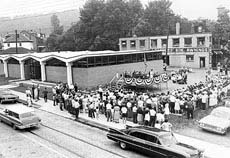
The Woods Run branch library, shown on opening day, July 8, 1964, is scheduled for interior renovation this year as well as for construction of a drive-through drop-off for books.
Let there be libraries
Carnegie opened his first public library in his hometown, Dunfermline, Scotland, in 1883. Rather than his name, he had a motto — “Let there be light” — carved within the Gothic-arched entrance; nevertheless, the three-story, turreted stone castle of a building announced that the weaver’s son had done rather well in America.
As many full-blooded Pittsburghers know, Carnegie erected his first public library in this country in his adopted hometown, Allegheny City, where as a youth he drank from the sweet chalice of knowledge in the home of Col. James Anderson, who opened his personal library on Saturday afternoons to the neighborhood’s working boys.
Braddock’s library had opened a year earlier, in 1889, but not as a publicly supported library. Braddock’s was fully funded by the Carnegie Steel Co. and governed by its officials — giving both the Braddock and Allegheny libraries bragging rights to firsts. Homestead’s library followed in 1898, Carnegie’s in 1901 and Duquesne’s in 1904.
While some of Carnegie’s steelworkers literally and figuratively had no time for his libraries, preferring the saloon and the lodge, other men and their wives learned English there at night and made good use of the libraries’ music halls, gyms, bowling allies, swimming pools and baths.
And their children and their children’s children embraced them. Monumental entrance arches, grand staircases, marble floors and hooded fireplaces transported girls and boys to another world. The medieval French chateau and the Renaissance palazzo, set down amid fire-breathing furnaces, clapboard houses and courtyards strung with laundry, gave hope to children in the first half of the 20th century that life wasn’t all blood, sweat and soot. Best of all, the shelves were lined with books, and you could carry your dreams right out the front door.
For the Allegheny library, Washington, D.C., architects Smithmeyer & Pelz drew not from the lavish, ornate classicism of their 1873, Renaissance-style design for the Library of Congress but from Boston architect Henry Hobson Richardson’s smaller, asymmetrical, towered New England libraries in rusticated stone.
Smithmeyer & Pelz gave the Allegheny City library foyer a wide, white marble staircase leading to the second floor, much as patrons would have found in one of the homes on nearby Ridge Avenue. Beyond the entrance hall was the “delivery room,” where books fetched by librarians from closed stacks were dispensed to readers. At one end of the room, an early photograph shows, Andrew Carnegie’s benevolent gaze greeted them from above a roaring fireplace. To the right of the delivery room was the men’s reading room and, in a small alcove, the women’s reading room.
There was no children’s room in the Allegheny City library — that innovation belongs to the Lawrenceville library of 1898 — but for adults and children alike, the Allegheny library’s “homey touches encouraged readers to think that the hierarchy was sustained not just by economic power but by mutual love and respect, as in an extended family,” writes architectural historian Abigail Van Slyck in “Free to All,” her 1995 book on Carnegie libraries. “Library users might then look upon Carnegie as a rich uncle, who deserved respect, obedience and affection, and whose affection in return precluded any class resentment.”
Carnegie still presides over the library’s former delivery room, but not from over the fireplace mantel. A 1970s renovation gutted most of the original interior. Today, as Pittsburgh’s Allegheny branch, the library is bright, white, modern and actively used. But it has lost its grand staircase, fireplace and all of its domestic and hierarchical connotations. Uncle Andy’s portrait hangs unceremoniously above a periodicals rack, flanked by the men’s and women’s bathrooms.
Visitors will have little trouble stepping back a century in the Braddock and Carnegielibraries, which have accommodated new technology without sacrificing the cozy comfort of their historic interiors. In both locations, Carnegie’s portrait still hangs over the fireplace.
Like the Andrew Carnegie Free Library of Carnegie, the Carnegie Library of Homestead is majestically sited near a hilltop, overlooking the town and the river valley. Opened in 1898, it has seen some interior alterations over the years — for one thing, the fireplace gave way to bookshelves — but it’s still standing and serving its community — more than can be said for the 1904 library in nearby Duquesne. Rivaling the Homestead and Carnegie libraries in size and setting, the Duquesne building was demolished in 1968 to make way for a school district building that was never built. The library site is now Library Court, a cul-de-sac of ranch houses.
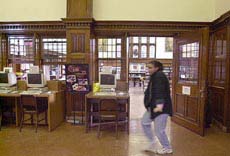
A distinguishing feature of Pittsburgh's Carnegie library branches is the wood and glass partitions between rooms, which allowed a single librarian to watch over the entire facility. At the Homewood library, shown here with a view from the lobby into the children's reading room, sections of the partitions will be removed to create better flow between the lobby and the adult and children's reading rooms. (Joyce Mendelsohn, Post-Gazette)
A late bloomer
Pittsburgh also was getting in on the library boom, even if it was a little late to the party. In 1881, the same year Carnegie began his first library in Dunfermline, he offered Pittsburgh $250,000 for a library if the city would provide the land and $15,000 annually for its maintenance. It was an offer the city could and did refuse, believing it was not a state-sanctioned use of public money.
By 1887, with the city assured by the state legislature that a public library was an appropriate use of tax funds, Pittsburgh officials told Carnegie they were ready to accept his gift. In 1890, the philanthropist expanded his original offer to $1 million for a conjoined central library and art museum, as well as branch libraries in the neighborhoods, which Carnegie came to view as more important in elevating the working class. Eventually, his gift to Pittsburgh would total $1,160,614.
Twelve years after the initial offer, construction began on the central library and museum in Oakland, following a design competition won by Longfellow, Alden & Harlow of Pittsburgh and Boston. But not long after it opened, the library was found to be woefully inadequate. For one thing, everybody forgot about the kids.
“So little thought was given to children as library users before 1895 that no provision was made for them,” library director Ralph Munn wrote in 1969. The library also had no room for scientific and technical books. An addition, opened in 1907, solved both problems, as well as one that had vexed Carnegie for more than a decade. The twin towers that flanked the music hall — “donkey ears,” he called them — were demolished in the expansion.
Today, Elish said, the problem with the main library is its organization: “You sort of need a secret handshake to find your way around.”
Books are shelved in unpredictable locations and departments, and even once visitors identify where a book is, they can have a hard time finding it.
To remedy that, Friendship-based EDGE architecture is working with librarians and South Side’s MAYA Design to reorganize and, as MAYA likes to put it, “tame the complexity.” MAYA analyzed why people couldn’t find what they were looking for and discovered that, in a library with millions of items spread over a labyrinth of rooms, “wayfinding” is an issue right up there with book-finding.
EDGE’s $3.1 million design is still being refined and won’t be ready for public review for a couple of months.
“We’re looking to make an environment that’s a destination because it’s entertaining, it’s informative and it’s an exciting place to be — and not do anything that violates the existing architecture and character,” said EDGE architect Gary Carlough.
Work could begin as early as mid-summer, but Dunham said it’s too soon to say how long the renovation might take.
While the branch libraries have gone or will go through a neighborhood input process in their renovation planning stages, for the main library, that process will happen in public hearings before City Council, a requirement for any project in the main library with more than a $1 million budget.
A first for Lawrenceville
After impressing Carnegie with the quality of their work — and their ability to stay on budget — Longfellow, Alden & Harlow, who also completed an 1893 addition to the Braddock library, would go on to design the Homestead and Duquesne libraries and, as Alden & Harlow, eight Pittsburgh branches, as well as libraries in Oakmont, Erie and, in Ohio, at Salem and Steubenville.
The first of the Pittsburgh branches, completed in 1898, was in Lawrenceville, the densely built neighborhood of factories and brick rowhouses. The library was built on residential Fisk Street, in the heart of the neighborhood but not on the main drag.
No more would Carnegie build big, homey castles, as he had done in the towns with which he had personal associations. Correspondingly, Alden & Harlow “divested their libraries of the domestic connotations that had appealed to the paternalistic philanthropist of 1880, and allowed the buildings to convey their public nature to prospective readers,” Van Slyck writes. The branch libraries would be classical and symmetrical, and done in brick to better fit their surroundings.
With a then-revolutionary open-shelf policy in all branches, the small libraries were planned so one librarian could oversee the entire operation. That dictated the interior plans of all the Pittsburgh branches, beginning at Lawrenceville and continuing through West End and Wylie Avenue (1899), Mount Washington and Hazelwood (1900), East Liberty (1905), South Side (1908) and Homewood (1910).
Lawrenceville was “the most innovative and important of these Pittsburgh branch libraries,” a design that “broke with Richardsonian precedent in both style and plan,” writes Margaret Henderson Floyd in “Architecture After Richardson,” her 1994 book on Longfellow, Alden and Harlow.
Located just beyond the lobby, the circulation desk — no longer a delivery desk — took center stage in Lawrenceville, flanked by turnstiles that admitted readers to the open stacks one at a time, under the librarian’s watchful eye. To thwart thievery, the stacks were arranged in a radial pattern. On each side of the lobby were a general reading room and, for the first time in a library anywhere, a room for children, many of whom were learning English as a second language or had immigrant parents. The reading rooms were separated by walls that became glass partitions above waist level — the better to see you with, my dear.
Despite such controlling devices, the library was well used. Over a six-week period in 1925, for example, a YWCA study of the Lawrenceville library found that 190 young women between 18 and 25 requested 736 books, 590 of which were fiction; the most popular writer was Pittsburgh’s own Mary Roberts Rinehart.
The Lawrenceville design — a rectangle with a semicircular rear projection to accommodate the radial stacks — was repeated at East Liberty, but economy forced other branches into a mostly rectangular plan, with shelves lining the perimeter walls.
The plan developed here became a model for Carnegie libraries around the world, and, in 1911, was included in a design advisory pamphlet issued by Carnegie’s secretary, James Bertram, who reviewed the plans of all Carnegie libraries after 1908.
The East Liberty library, serving the wealthy East End community, was the largest of the branches when it opened, but it was demolished in the late 1960s to accommodate the city’s ill-fated urban renewal plan for the commercial district.
The Wylie Avenue branch moved from its historic building to a new location in 1982, because demolition of the Lower Hill neighborhood in the 1960s had left it at one end of its former service area. The building now houses a mosque.
But the six branches that survive as libraries — Lawrenceville, West End, Mount Washington, Hazelwood, South Side and Homewood — have a remarkably high degree of integrity, inside and out.
A dwindling legacy
By 1917, Carnegie had invested $68,333,973 in libraries here and abroad, equivalent to about $966 million today. Of the 1,689 Carnegie libraries built in America, at least 350 have gone on to other uses, writes Theodore Jones in his 1997 book, “Carnegie Libraries Across America: A Public Legacy.” Another 259 have been razed or destroyed by fire or other natural disasters — 100 in the 1960s, 47 in the 1970s, 12 in the 1980s, a downward trend fueled by the historic preservation movement.
But that trend, Jones writes, has been reversing since the 1990 passage of the Americans with Disabilities Act.
“Public libraries are moving out of their original Carnegie buildings more frequently than ever,” he writes. According to 1991 and 1996 surveys, of the 350 or so libraries that have been reused, 60 were still libraries in 1991.
Elish has said he would consider selling a branch building if it proves too expensive to upgrade or is in a difficult location that lacks parking, but he is keeping an open mind and hopes Pittsburghers will do the same. He also wants to hear from the community.
“We don’t want to get in a position of saying, ‘We don’t want to be in [the old] building’ and have the community rise up in arms” and not use the new building, Elish said. But, he adds, “Part of this is a cost problem. If you find that the renovation of a building is prohibitive compared to what you’re going to get in a new building, you need to lay out the costs and talk about them. You can’t make irresponsible decisions.
“I just think by the end of all of the conversations about this, that good sense will prevail on both sides. We will learn from each other and reach a conclusion together.”
It’s a dialogue that should engage everyone who has a stake in the future of Pittsburgh’s archetypal neighborhood libraries.
-
Farmers Pursue New Purposes to Preserve Age-Old Livelihood
Thursday, September 16, 2010By Karen Kane, Pittsburgh Post-GazetteThere’s a saying in farm circles: Get big or get out. But some farmers here are proving there’s another way to survive. Diversification — essentially a “re-purposing” of the family farm — is bolstering profits and enhancing staying power at a time when many farmers feel forced to trade their tractors for briefcases or hard hats.
The strategies are varied: the berry farmer who begins baking and selling berry pies; the crop farmer who opens his land for hunting; the tree farmer who transforms a barn into a gift shop.
Each strategy has two things in common: eliminating the middleman — which strengthens the connection between the farmer and the public — and putting more money in the pockets of the farmers’ overalls.
It’s win, win, win — for the farmers looking to preserve their way of life; for a region in which agriculture is a key economic generator; and for suburbanites and others who yearn for locally produced foods.
Rooted in ideasThe future of family farming will be rooted as much in creative thinking as in the dirt, said Leah Smith of the Pennsylvania Association for Sustainable Agriculture. The group’s mission is to promote profitable farms that produce healthy food and respect the environment.
“We are challenging the conventional idea that you either get big or get out in agriculture. We are finding new ways to connect with consumers and give them an opportunity to get closer to the family farm,” Ms. Smith said.
For John Kennedy of Middlesex, the son of a dairy farmer, it “hit him hard” as a teenager that “there are only so many ways to support yourself on the farm, and I’d better start trying some more.”
He was in high school when the drought of 1988 struck, sending shock waves through the farming community. “I realized that I didn’t want to be totally at nature’s mercy for my livelihood, but I wanted to continue to farm,” he said.
He sold the Camaro he had bought with his 4-H project earnings over the years and used the money to buy game birds. He and his wife, Valarie, now operate the 450-acre Four Seasons Game Bird Farm, a regulated hunting preserve in Middlesex.
The couple still raise crops and animals on the land, but when the growing season is just about finished, the property is opened for guided hunting expeditions for ring-necked pheasant, quail and chukar partridges.
“To … pay the bills and have any type of extra, you can’t just do one type of farming any more,” Mrs. Kennedy said. She said that she and her husband knew before they began raising their three children — ages 4, 8 and 11 — that farming was the lifestyle they wanted. And they knew they needed to diversify to make it work.
That’s the message that Jane Eckert conveys when she speaks at conventions across the U.S. The owner of Eckert AgriMarketing in St. Louis, Ms. Eckert is a consultant who has made it her mission to help the family farm survive.
“It’s about supplementing a farmer’s income,” said Ms. Eckert, who comes from a long line of farmers. “The family farm today has a very hard time making it economically. But people in this business are in it because they love farming.”
She said her focus is helping a farmer recognize a strategy for diversification.
“We look at the land, the assets and we say, ‘Gee, how about adding a snowmobiling trail for winter?’ Or, we explore the value of selling their products on the farm or starting a B&B or opening up for pick-your-own,” she said.
So’Journey Farm, Greene CountySandra Brown, owner of So’Journey Farm in Jackson, did just that.
A rug-weaver who conducts workshops on the craft, she moved from Pittsburgh to the 45-acre farm five years ago at age 58 with a desire for farm living and a determination to make it income-producing.
She zeroed in immediately on livestock — she says she has a “real passion for growing really good food” — and figured that using her 1880s farmhouse as a B&B would add a level of financial certainty to the operation.
“I knew going in that agritourism was the way to go,” she said.
She now raises laying hens, French roasting chickens and Scottish Highland beef cattle. She “harvests” her own animals and makes the most of her assets, moving her chickens around to feed so their manure will fertilize different areas of the farm and turning over her orchard to her cattle for grazing. She barters with local farmers for use of heavy equipment that she doesn’t want to buy and makes direct sales to consumers, charging premium prices — $4.50 a pound for the roasters, for example — for her grass-fed beef and her free-ranging chickens.
Asked about profitability, she answers: “It’s more than paying for itself.”
Sand Hill Berries, Westmoreland CountyAt Sand Hill Berries in Mount Pleasant Township, one might say the story began humbly — with pie.
Susan Lynn, who bought the 110 acres in 1981 with her husband, Richard Lynn, said what has become a major farm, food and tourist operation happened “almost by pure accident.”
Initially, the couple began planting trees: sugar maple, apples, pears, peaches and sour cherries. But they noticed that raspberries were growing wild throughout the property. Thanks to pure serendipity, they came upon someone desperate to move 7,000 raspberry bushes and they got them cheap. When the bushes began bearing fruit, the Lynns did what most growers do: They sold the berries wholesale — until one year when unseasonably hot weather produced poor-quality California berries that drove down berry prices.
“That made us see that we needed other venues for the product,” she said.
The next thing she knew, she was marketing berry pies and dessert toppings directly to festivals.
Then came a Victorian-era raspberry-infused vinegar. Then jams and jellies for gift baskets. Then a little on-site retail store to sell the products. Then a dessert cafe on the farm for those who were visiting and wanted just a piece of pie. In 2007, they added a winery and a Nectar Garden.
Soon, people were asking to be married on the property and to hold receptions there.
“We’ve got people waiting for dates in 2012,” Mrs. Lynn said of the operation that now involves other members of the family as well as a couple of outside partners.
Mrs. Lynn said the enterprise has been and continues to be an adventure that isn’t making them rich but is keeping the family in business.
“We grow what we sell. We’re proud of that. There’s no middleman,” she said.
Her advice to others: “If you grow raspberries, you better make jelly.”
Hozak Farms, Beaver CountyMarty Hozak of Hozak Farms in Hanover agrees that diversification transformed their family farm from a “standard pigs-chickens-and-egg operation” that barely supported his grandfather to an enterprise that supports himself; his son; his parents, Bob and Virginia; and his sister, Ellen Dillon.
The change began when his father read an article while in college that said raising Christmas trees could be a money-making venture. The first planting was in 1949.
For several years, Bob Hozak wholesaled the cut trees and, as the son puts it, “It was easier money than chickens.” But soon the realization dawned that direct sales was more profitable.
“We started having people who wanted to cut their own tree. And that’s when things began rolling,” Marty Hozak said.
The occasional cut-your-own request became an all-out effort to “create an experience, make a memory” for the visitor, with tractors that hauled customers out to the woods and a gift shop in a renovated barn where tree lights and ornaments were displayed.
For a number of years, the Hozaks were all about Christmas. Then, in the 1980s, they decided to expand their season to include fall. A pumpkin patch was grown and the tractors that were used to transport tree-cutters were used for fall hayrides.
The next step is figuring out what to do in spring or summer.
“If you want to make a go of it in family farming nowadays, you don’t just grow one crop or do one thing,” Marty Hozak said. “You get creative. You diversify.”
-
Blaze Destroys Landmark Building in Edgeworth
Thursday, September 16, 2010By Moriah Balingit, Pittsburgh Post-GazetteIt took just a handful of minutes for a fast-moving blaze to destroy nearly a century and a half of history as it tore through a Edgeworth home Wednesday afternoon
Owners Roger Wiegand and his wife Kay and three or four others were at the house, located at 420 Oliver Road, when smoke detectors went off, alerting local firefighters at 4:18 p.m. Everyone made it out safely, but by the time firefighters and police arrived on scene, the fire had already spread to all floors.
“When I went in … it was full of smoke,” said Patrolman Paul Yonlisky, of the Edgeworth Police Department, who said he was the first on scene. He quickly turned back.
By the time Chief Tim Scott, of the Edgeworth Volunteer Fire Department, arrived on scene, about four minutes after the initial call, he could see fire and smoke on both floors, and flames were licking the eaves of the home.
“It was already into the attic space,” he said.
It took more than three hours and 40 to 50 firefighters from six area companies to extinguish the fire. Chief Scott expected to have firefighters there late into the night to ensure that there were no hot spots.
The fast-moving blaze was likely stoked by the house’s old wooden frame, he said.
The facade of the home that faced Oliver Road, a stately colonial brick structure painted white, remained mostly intact Wednesday evening, as firefighters continued to search for hot spots in the five-bedroom, 7,600 square foot home. But the home’s steep slate roof had caved in and remained intact in only one corner of the house, said Chief Scott. The interior of the home had been gutted in parts, and a stairwell had collapsed.
Still, firefighters who filed in and out of the home carted out artwork, some fronted by shattered glass, delivering it to family members standing nearby. A large flat-screen television also survived the fire.
And Chief Scott said he believes the home can be rebuilt.
Paula Doebler, a close friend of Mrs. Wiegand’s who lives in nearby Sewickley, rushed to the scene when she heard on the news that the house was on fire. She said that Mrs. Wiegand is an interior decorator, and the house, which features a roof porch supported by iconic columns, was among her crown jewels.
Mrs. Wiegand had just remodeled the kitchen and the home’s style was “slowly but surely changing over to contemporary.”
“The home was just beautiful,” she said.
Chief Scott said Mrs. Wiegand was “very upset.”
The family declined comment at the scene.
Built in the mid-1800’s, the mansion was once home to the Edgeworth Female Seminary, a school for girls. It was named for Irish novelist Mary Edgeworth and drew students from New England and the South.
Later, the home become the property of the Edgeworth Social Club. When the borough was founded in 1904, it took the name Edgeworth, according to the borough’s website.
-
Between a Ramp and a Hard Place
Friday, September 10, 2010 11:33 AMWritten by Diana Nelson Jones
To some people, the historic standards that prohibit vinyl windows and metal awnings are dictatorial. To others, those standards safeguard authenticity and dumbing down is not an option.
When it’s your own budget, a little gray can seep into the argument.
Even someone who appreciates the high standards that are supposed to be followed in an historic district can sympathize with a building owner who needs to replace five 10-foot-tall windows in a group of Victorian row houses. Ouch.
But when you buy in an historic district you’re investing in more than a building.
The people of Calvary United Methodist Church in Allegheny West have been diligent in following the historic course. Their partner, the Allegheny Historic Preservation Society, helped them raise the more than $2 million needed for interior and exterior repairs in the late 1990s. That included removing some of the world’s largest Tiffany windows for cleaning and releading.
Visit their web site at www.calvarypgh.com.
They have raised about $180,000 for the next “must-do” project — making their fellowship hall in the basement accessible to the increasing numbers of people who use the church. They are anticipating six bids for a job that calls for an elevator, a new door carved into the side off the parking lot and a 30-foot ramp with an historically acceptable railing and ramp foundation. Which means limestone.
Based on the first bids to come in, Rev. Larry Homitsky tells me, the church is short somewhere between $75,000 and $120,000. The Historic Review Commission offered some flexibility on the railing but insisted on the limestone. Rev. Homitsky and the church’s architect will reappear before the HRC next month, maybe with hat in hand.
He said the church has had “tremendous support” over the years in grants and other gifts. Many people see Calvary as more than a church, in part because it is on the National Register of Historic Places and also because thousands of people a week, mostly from the community but not necessarily in the congregation, use it to practice yoga, square dance, learn art and confirm the day-at-a-time struggle against addiction. The Allegheny West Civic Council meets there the second Tuesday of every month. A lot of brides who want a beautiful church for their wedding pick Calvary instead of the one they go to. More than 1,000 Christmas house tourists converge on the church as a point of interest.
The time, effort and money spent in being an historic property is important, said Rev. Homitsky. That, set alongside the “ministry value” of functioning for people is the challenge.
If you want to help Calvary make their basement accessible and do it at historic standards, they will take donations. Specify on your check that it is meant for the ramp and elevator project and mail it to the church at 971 Beech Ave., Pittsburgh 15233.
-
Between a Ramp and a Hard Place
Friday, September 10, 2010 11:33 AMWritten by Diana Nelson Jones
To some people, the historic standards that prohibit vinyl windows and metal awnings are dictatorial. To others, those standards safeguard authenticity and dumbing down is not an option.
When it’s your own budget, a little gray can seep into the argument.
Even someone who appreciates the high standards that are supposed to be followed in an historic district can sympathize with a building owner who needs to replace five 10-foot-tall windows in a group of Victorian row houses. Ouch.
But when you buy in an historic district you’re investing in more than a building.
The people of Calvary United Methodist Church in Allegheny West have been diligent in following the historic course. Their partner, the Allegheny Historic Preservation Society, helped them raise the more than $2 million needed for interior and exterior repairs in the late 1990s. That included removing some of the world’s largest Tiffany windows for cleaning and releading.
Visit their web site at www.calvarypgh.com.
They have raised about $180,000 for the next “must-do” project — making their fellowship hall in the basement accessible to the increasing numbers of people who use the church. They are anticipating six bids for a job that calls for an elevator, a new door carved into the side off the parking lot and a 30-foot ramp with an historically acceptable railing and ramp foundation. Which means limestone.
Based on the first bids to come in, Rev. Larry Homitsky tells me, the church is short somewhere between $75,000 and $120,000. The Historic Review Commission offered some flexibility on the railing but insisted on the limestone. Rev. Homitsky and the church’s architect will reappear before the HRC next month, maybe with hat in hand.
He said the church has had “tremendous support” over the years in grants and other gifts. Many people see Calvary as more than a church, in part because it is on the National Register of Historic Places and also because thousands of people a week, mostly from the community but not necessarily in the congregation, use it to practice yoga, square dance, learn art and confirm the day-at-a-time struggle against addiction. The Allegheny West Civic Council meets there the second Tuesday of every month. A lot of brides who want a beautiful church for their wedding pick Calvary instead of the one they go to. More than 1,000 Christmas house tourists converge on the church as a point of interest.
The time, effort and money spent in being an historic property is important, said Rev. Homitsky. That, set alongside the “ministry value” of functioning for people is the challenge.
If you want to help Calvary make their basement accessible and do it at historic standards, they will take donations. Specify on your check that it is meant for the ramp and elevator project and mail it to the church at 971 Beech Ave., Pittsburgh 15233.
-
Hiding in Plain Sight: A House as Old as Larryville
The house on the southwest corner of 38th St. and Charlotte Street in Lawrenceville is up for sale. It was bult a decade after Lawrenceville became a town in 1814.
We know this because house historian Carol Peterson, a denizen of Larryville, researched the records. The house you see now — ruddy-colored clapboards, patched in part with old tin advertisements — encloses the original log home that was built in the 1820s. The “new” part is from the 1870s. That’s Michael Connors in front of it. Michael has been part of the Lawrenceville Historical Sociaty’s efforts over the years to get it, and to have it renovated.
Read Michael’s “Next Page” in the Post-Gazette on Sept. 12 for a story about one of the buildings past inhibitants, a teenager who packed munitions and died in the deadly arsenal explosion of 1882. And, by the way, thanks to Matt Smith, who was walking along with a smart phone and agreed to take the photo you see. (So, OK, the sun was in the wrong place.)
For some time, heavy hitters including the Pittsburgh History and Landmarks Foundation, Sen. Jim Ferlo and other public officials, were at least cheering on the historical society’s effort, Michael tells me.
Arthur Ziegler, president of Landmarks, said the interest and needed money could not be reconciled. “We don’t have many log houses left and we would like to save them,” he said, “but this had been so changed over the years, to put it back the way it was would have meant cutting new logs.”
The historical society “knew it was way beyond our ability” to afford and renovate, Michael said.
It is owned by a limited partnership. Historical Society members toured it a few years ago when the owners wanted $39,000. We’re trying to find out the asking price from the Realtor.
This building was part of the original town of Lawrenceville that composer Stephen Foster’s father subdivided. In 1841, Lawrenceville town was carved out of Pitt Township roughly from 38th to 41st Streets and from Woolslayer to the Allegheny River, Carol said. Lawrenceville was incorporated as a borough in 1834.
“Just think that someone in this house could have walked up the street to see the Marquis de Lafayette when he visited Pittsburgh” in 1825, Michael said. In case history isn’t your subject, Lafayette was a hero of both the French and American revolutions and knew George Washington.
He was our first president.
Michael said his dream is that UPMC, whose Children’s Hospital presence is “the biggest and newest” in the neighborhood, offers the needed largesse “for the smallest and oldest” and help Lawrenceville showcase one of its original structures, which could be an attraction for visitors to the hospital.
Walkabout is putting it out there, like a butterfly wish that might merge with the fluttering fancy of the right person…or institution.
-
Work on Former Hollow Tavern Progressing
By Jewels Phraner
LIGONIER ECHO
Thursday, September 2, 2010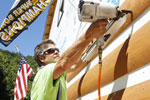
Fred Haeflein works on reviving the Hollow Tavern on Route 30 outside of Ligonier. Jared Wickerham | Tribune-Review
Saving Sleepy Hollow hasn’t gone exactly the way owner Fred Haeflein expected.
He’s had a skilled crew at work rebuilding the log landmark, but now he’s looking for a good chef and manager to operate the restaurant.
After an arson destroyed the building in February 2008, causing so much damage that Unity code enforcement officer Merle Musick condemned the property, Haeflein bought it with the intention of restoring it.
Financial troubles plagued the project early on, and this summer Haeflein said he has struggled to find the right person to run the restaurant. Although he has fond childhood memories of the restaurant, he has no interest in running the facility once it’s finished.
“I don’t cook. I’m not a restaurant manager,” Haeflein said. “I build things. I save things. I just want this building here.
“I need a good restaurateur – no, I need a great restaurateur – to keep this place running for a long time,” he said.
When the project ran into financial problems in early 2007, The Progress Fund, a Greensburg-based nonprofit lending organization approached Haeflein about a loan.
“That valley is so great. So many people enjoy driving through it. And we thought it would be a nice venue for people to stop and enjoy the valley,” said David Kahley, chief executive officer for the organization, which focuses on tourism-oriented projects.
Project loan officer Bob Patter said that while people might not see progress as they drive by the building, that doesn’t mean work isn’t being done behind the scenes.
“It’s still a very active project,” he said. “Fred is moving forward with it. Perhaps not at the pace everyone would like to see, but he’s trying to find the right person to run the restaurant for him.”
Haeflein said he expected to buy exterior logs for the building. But he wasn’t able to find the correct size and had to custom-make them instead.
“I wanted them to be as close to the original (Sleepy Hollow) as possible, and you just can’t buy logs that width anymore,” he said.
So Haeflein spent part of the summer using an ancient mill in his New York shop to cut logs, then transporting them to Ligonier.
“This is probably a lot like how the original logs were made,” he said. “It’s a pure miracle that (the mill) actually worked. That mill is probably as old as this building and hasn’t been used in 20 years.”
For now, only a few logs are secured to the building, but Haeflein said he will be back to finish the job soon.
Kelly’s Sleepy Hollow LLC was formed by Haeflein and his brother, Rich, who have been restoring the landmark west of Ligonier for about two years.
Edgar Wiltrout of Ligonier is serving a 10- to 28-year prison sentence for torching the restaurant and tavern on Feb. 23, 2008, because the former owner owed Wiltrout $1,000 and fired his girlfriend as a cook.
-
7 Homebuyers Sold on Manchester Vision
By Adam Brandolph
PITTSBURGH TRIBUNE-REVIEW
Thursday, September 2, 2010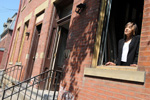
Linda Nelson, chairwoman of the Manchester Citizens Corporation, inspects one of the properties being restored on Columbus Avenue in Manchester. The home was purchased as part of the Great House Sale. Jasmine Goldband | Tribune-Review
For the first time in years, Anthony Clark sees a reason to invest in his North Side neighborhood.
“Manchester is really starting to get going, and after 15 years of renting, I think it’s a good time,” said Clark, 44. “I think we’re about to see some really great things.”
For years, the city demolished vacant homes in Manchester, turning usable buildings into weed-filled lots that became overrun with graffiti and trash. The vacant lots made selling homes difficult, and people living there say the community suffered despite the fact that police records show the number of crimes fell by nearly half over the past decade.
“When you have a tooth out, the disease begins to spread,” said Linda Nelson, chairwoman of the Manchester Citizens Corporation, a community group founded in 1965 that helped spur more than $40 million in developments and initiatives. “If (buildings) come out, it’s definitely a hindrance. If we can renovate them, it’s a plus.”
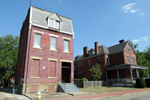
An abandoned structure (left) on the 1100 block of Bidwell Street in Manchester is one of several slated for rehabilitation. Jasmine Goldband | Tribune-Review
With the group’s managing director Stanley Lowe urging the city to save buildings from demolition, the wrecking ball slowed. Along with the Pittsburgh History & Landmarks Foundation, it identified 110 buildings that should be saved, 63 of which are considered a priority.
Lowe said he reminded members of the city’s Historic Review Commission about the neighborhood’s rich architectural and cultural heritage, which helped Manchester achieve city and national historic status in 1979.
“Once you tear down the building, you can never go back,” Lowe said.
In October, the citizens’ group showcased seven homes to be restored by March. More than 100 people, some from as far away as Venezuela and Colombia, attended a two-day session that included a seminar educating them about how to buy one of the homes.
Twenty-five people put down $1,500 deposits, and seven qualified buyers were chosen at random to buy the homes. The rest were put on a waiting list for future restorations.
“The homes were a terrible mess,” Nelson said. “But the people who came in saw our vision.”
The cost to restore each home will range from $150,000 and $450,000, but they will sell for $90,000 to $200,000.
Incentives totaling $2 million for the buyers will be paid by grants from the city’s Urban Redevelopment Authority, the federal Department of Housing and Urban Development, Allegheny County, the Pittsburgh History & Landmarks Foundation’s Landmarks Community Capital Corporation and the Allegheny Foundation.
City Councilman R. Daniel Lavelle, whose district includes Manchester, said the strategy “fits the city’s economic reality.”
“The city can’t afford to do it all at once, so (the citizens’ group has) identified key properties they want to save,” Lavelle said. “I think it’s a tremendous project.”
Preserving the “architectural fabric” of the historic district has been ongoing since the 1970s, said Arthur Ziegler, president of the landmarks foundation.
Rob Stephany, executive director of the redevelopment authority, said the restorations are a “really bright strategy,” especially because they’re near construction at Columbus Square, a $15 million, 31-home development on four acres.
“Manchester has everything working for it,” he said.


